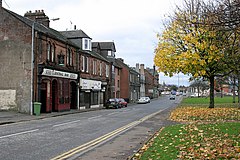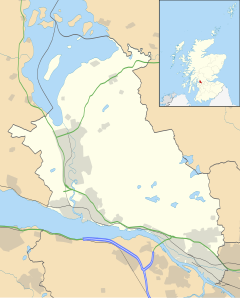
Alexandria is a town in West Dunbartonshire, Scotland. The town is on the River Leven, three miles north of Dumbarton and 15 mi (24 km) north-west of Glasgow.
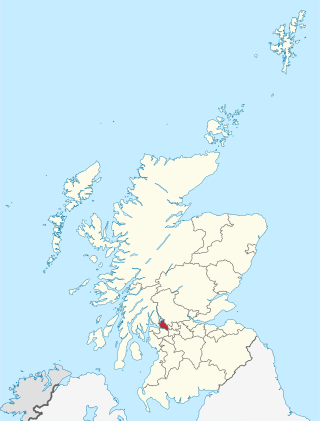
West Dunbartonshire is one of the 32 local government council areas of Scotland. The area lies to the north-west of the Glasgow City council area and contains many of Glasgow's commuter towns and villages. West Dunbartonshire also borders Argyll and Bute, East Dunbartonshire, Renfrewshire and Stirling.

Tobias George Smollett was a Scottish novelist, surgeon, critic and playwright. He was best known for picaresque novels such as The Adventures of Roderick Random (1748), The Adventures of Peregrine Pickle (1751) and The Expedition of Humphry Clinker (1771), which influenced later novelists, including Charles Dickens. His novels were liberally altered by contemporary printers; an authoritative edition of each was edited by Dr O. M. Brack Jr and others.
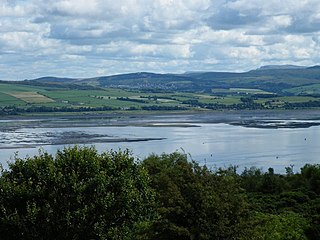
The Vale of Leven is an area of West Dunbartonshire, Scotland, in the valley of the River Leven. Historically, it was part of The Lennox, the name of which derives from the Gaelic term Leamhnach, meaning field of the Leven. Leamnha is thought to mean elm-water.

Dunbartonshire or the County of Dumbarton is a historic county, lieutenancy area and registration county in the west central Lowlands of Scotland lying to the north of the River Clyde. Dunbartonshire borders Perthshire to the north, Stirlingshire to the east, Lanarkshire and Renfrewshire to the south, and Argyllshire to the west.

Dumbarton is a town in West Dunbartonshire, Scotland, on the north bank of the River Clyde where the River Leven flows into the Clyde estuary. In 2006, it had an estimated population of 19,990.
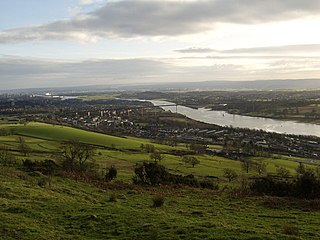
Clydebank is a town in West Dunbartonshire, Scotland. Situated on the north bank of the River Clyde, it borders the village of Old Kilpatrick to the west, and the Yoker and Drumchapel areas of the adjacent City of Glasgow immediately to the east. Depending on the definition of the town's boundaries, the suburban areas of Duntocher, Faifley and Hardgate either surround Clydebank to the north, or are its northern outskirts, with the Kilpatrick Hills beyond.
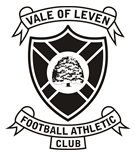
Vale of Leven Football Club is a Scottish football club based in the town of Alexandria, in the Vale of Leven area of West Dunbartonshire. Nicknamed the Vale and formed in 1939, they play at Millburn Park. They play in the West of Scotland League Third Division, the ninth tier of Scottish football.
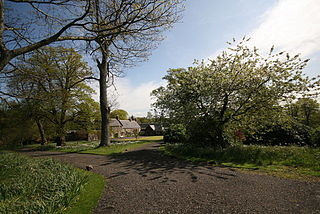
Cardross is a large village with a population of 2,194 (2011) in Scotland, on the north side of the Firth of Clyde, situated halfway between Dumbarton and Helensburgh. Cardross is in the historic geographical county of Dunbartonshire but the modern political local authority of Argyll and Bute.

The River Leven is a stretch of water in West Dunbartonshire, Scotland, flowing from Loch Lomond in the North to the River Clyde in the South. The river is about 6 miles long. It is very popular with salmon and sea trout anglers, trying to catch one of these migratory fish going up to Loch Lomond.
Patrick Travers was a Scottish football player and manager in the first half of the 20th century. He played for many clubs in his native Scotland and for Barnsley in England, before becoming involved in coaching, and later, management, winning the Scottish Cup with Clyde on two occasions either side of World War II.
Renton Football Club was a football club based in Renton, West Dunbartonshire, Scotland. Formed in 1872, it was a prominent team in the early history of Scottish football, and was one of the teams that featured in the first ever Scottish Cup fixture. It won the competition twice, in 1885 and 1888, and was also runners-up three times. Its 6–1 win against Cambuslang in 1888 is the joint record win in a Scottish Cup final.
Tontine Park was a football ground in Renton, West Dunbartonshire, Scotland. It was the home ground of Renton F.C. from 1878 until 1922, including their time in the Scottish Football League.

The 1878–79 Scottish Cup – officially the Scottish Football Association Challenge Cup – was the sixth season of Scotland's most prestigious football knockout competition. Defending champions Vale of Leven met Rangers in the final but, after a 1–1 draw in the original match on 19 April 1879, the replay was scratched and Vale of Leven were awarded the cup. Rangers objected to a goal being disallowed in the original match and refused to play the replay.
The 1885 Scottish Cup Final was the 12th final of the Scottish Cup and the final of the 1884–85 Scottish Cup, the most prestigious knockout football competition in Scotland. For only the second time in the competition's history, the final was contested by two teams from outside Glasgow: Renton, who had never won the cup before, and three-time winners Vale of Leven, representing neighbouring communities in Dunbartonshire.
Dalmoak House, is a Category A listed building off the A812 Renton Road in the ancient Parish of Cardross. It sits between the village of Renton and the town of Dumbarton on the North side the Firth of Clyde in Dunbartonshire, Scotland. It was built in a Scottish baronial style by the architect Alexander Watt in 1866–69, or 1866-1869 according to some sources, for John Aiken of Glasgow. Aiken's involvement in the wine and spirits mercantile trade was the basis for the house's nickname, 'Brandy Castle', which has been in use ever since.
Star of Leven Football Club was an association football club based in the town of Alexandria, in the Vale of Leven area of West Dunbartonshire.
Alclutha Football Club was a football club based in Dumbarton, Scotland. From 1883 the club was called Dunbritton Football Club.
Jamestown Football Club was an association football club based in the village of Jamestown, in the Vale of Leven area of West Dunbartonshire, which entered the Scottish Cup from 1878 to 1890.
